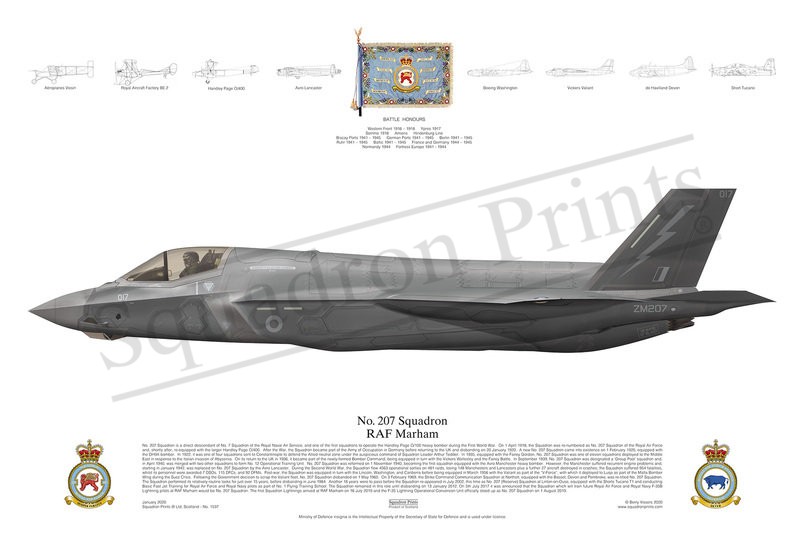#1537 F-35B Lightning

Description
Squadron Prints Lithograph No. 1437 - ZM207, F-35B Lightning, No. 207 Squadron, RAF Marham.
No. 207 Squadron is a direct descendant of No. 7 Squadron of the Royal Naval Air Service, and one of the first squadrons to operate the Handley Page O/100 heavy bomber during the First World War. On 1 April 1918, the Squadron was re-numbered as No. 207 Squadron of the Royal Air Force and, shortly after, re-equipped with the larger Handley Page O/400. After the War, the Squadron became part of the Army of Occupation in Germany before returning to the UK and disbanding on 20 January 1920. A new No. 207 Squadron came into existence on 1 February 1920, equipped with the DH9A bomber. In 1922, it was one of four squadrons sent to Constantinople to defend the Allied neutral zone under the auspicious command of Squadron Leader Arthur Tedder. In 1935, equipped with the Fairey Gordon, No. 207 Squadron was one of eleven squadrons deployed to the Middle East in response to the Italian invasion of Abyssinia. On its return to the UK in 1936, it became part of the newly-formed Bomber Command, being equipped in turn with the Vickers Wellesley and the Fairey Battle. In September 1939, No. 207 Squadron was designated a ‘Group Pool’ squadron and, in April 1940, was merged with two other squadrons to form No. 12 Operational Training Unit. No. 207 Squadron was reformed on 1 November 1940, becoming the first squadron equipped with the Avro Manchester heavy bomber. However, the Manchester suffered recurrent engine problems and, starting in January 1942, was replaced on No. 207 Squadron by the Avro Lancaster. During the Second World War, the Squadron flew 4563 operational sorties on 481 raids, losing 148 Manchesters and Lancasters plus a further 27 aircraft destroyed in crashes; the Squadron suffered 954 fatalities, whilst its personnel were awarded 7 DSOs, 115 DFCs, and 92 DFMs. Post-war, the Squadron was equipped in turn with the Lincoln, Washington, and Canberra before being equipped in March 1956 with the Valiant as part of the “V-Force”, with which it deployed to Luqa as part of the Malta Bomber Wing during the Suez Crisis. Following the Government decision to scrap the Valiant fleet, No. 207 Squadron disbanded on 1 May 1965. On 3 February 1969, the Strike Command Communication Squadron at Northolt, equipped with the Basset, Devon and Pembroke, was re-titled No. 207 Squadron. The Squadron performed its relatively routine tasks for just over 15 years, before disbanding in June 1984. Another 18 years were to pass before the Squadron re-appeared in July 2002, this time as No. 207 (Reserve) Squadron at Linton-on-Ouse, equipped with the Shorts Tucano T1 and conducting Basic Fast Jet Training for Royal Air Force and Royal Navy pilots as part of No. 1 Flying Training School. The Squadron remained in this role until disbanding on 13 January 2012. On 5th July 2017 it was announced that the Squadron which will train future Royal Air Force and Royal Navy F-35B Lightning pilots at RAF Marham would be No. 207 Squadron. The first Squadron Lightnings arrived at RAF Marham on 16 July 2019 and the F-35 Lightning Operational Conversion Unit officially stood up as No. 207 Squadron on 1 August 2019.
You may also like
-
1 Group Air Command
ZZ416; ZH103; P7350; ZJ692; XX200 'CO'; ZZ665; ZP801; ZK332; ZZ203; ZM151; ZG8481 Grp
